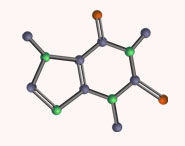


 علم الكيمياء
علم الكيمياء 
 الكيمياء التحليلية
الكيمياء التحليلية 
 الكيمياء الحياتية
الكيمياء الحياتية 
 الكيمياء العضوية
الكيمياء العضوية 
 الكيمياء الفيزيائية
الكيمياء الفيزيائية
 الكيمياء اللاعضوية
الكيمياء اللاعضوية 
 مواضيع اخرى في الكيمياء
مواضيع اخرى في الكيمياء
 الكيمياء الصناعية
الكيمياء الصناعية |
أقرأ أيضاً
التاريخ: 8-7-2018
التاريخ: 15-10-2020
التاريخ: 14-10-2019
التاريخ: 2025-04-15
|
The bond angles in compounds with carbon-carbon double bonds such as ethene are closer to 120o than to the normal tetrahedral value of 109.5o. There are several way sin which a carbon-carbon double bond can be formulated in terms of atomic-orbital models. One very popular approach is to consider that ethene has two sp2-hybridized carbons that form one carbon-carbon σ bond and four carbon-hydrogen σσ bonds by overlap of the six sp2 orbitals, as shown in Figure 6-14. The remaining carbon-carbon bond is formulated as arising from sidewise overlap of the two pp orbitals, one on each carbon, that are not utilized in making the sp2 hybrids. Sidewise overlap of pp orbitals is called π overlap to distinguish it from the endwise σ overlap of the type we have discussed previously (Figure 6-15). The resulting π bond differs from the σ bond in that electron density is concentrated in the regions above and below the bond axis rather than along the bond axis.
Figure 6-14: The σσ-ππ formulation of ethene
Formulations of ethene in this way suggests that it should be a planar molecule with H−C−H angles of 120o. Ethene is indeed planar, but its H−C−H angles are found to be 117o, rather than the 120o predicted for sp2 bonds. An explanation of this discrepancy using further electron-repulsion arguments will be discussed later in the chapter.
Figure 6-15: Schematic representation of σ overlap and π overlap of p orbitals
The simple elegance of the σσ-ππ model of ethene should not be taken as proving that there actually are two different kinds of bonds between the carbons. The σ-π representation of double bonds is not really unique. Given sp2 hybridization of the carbons so there are sp2-σ bonds to the hydrogens, it is possible to take the sp2 and pp orbitals used for the σ and ππ bonds, rehybridize them, and so derive a new set of overlapping orbitals for the double bond. These orbitals are called τ (tau) bonding orbitals and can be represented by two banana-shaped orbitals between the carbons (Figure 6-16). The result is two completely equivalent C−C bonds. The τ model has the advantage of offering a striking parallel to ball-and-stick models, whereas the σ-π model is of particular value as a basis for quantitative calculations.
Figure 6-16: Formulation of ethene with τ bonds. Each τ orbital is considered to contain an electron pair.
Using the σ-π model of double bonds, we conclude that the twisted configuration shown in Figure 6-17 should not be very stable. Here the p orbitals are not in position to overlap effectively in the π manner. The favored configuration is expected to have the axes of the p-π orbitals parallel. Because considerable energy would have to be expended to break the p-π double bond and to permit rotation about the remaining sp2-σ bond, restricted rotation and stable cis-trans isomers are expected. Similar conclusions can be reached on the basis of the τ model of the double bond.
Figure 6-17: Orientation of p orbitals in twisted configuration of ethene



|
|
|
|
التوتر والسرطان.. علماء يحذرون من "صلة خطيرة"
|
|
|
|
|
|
|
مرآة السيارة: مدى دقة عكسها للصورة الصحيحة
|
|
|
|
|
|
|
نحو شراكة وطنية متكاملة.. الأمين العام للعتبة الحسينية يبحث مع وكيل وزارة الخارجية آفاق التعاون المؤسسي
|
|
|